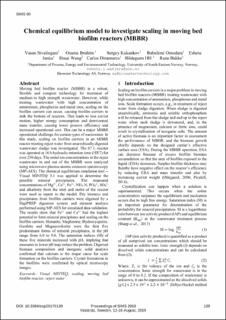| dc.contributor.author | Sivalingam, Vasan | |
| dc.contributor.author | Ibrahim, Osama M. | |
| dc.contributor.author | Kukankov, Sergey | |
| dc.contributor.author | Omodara, Babafemi | |
| dc.contributor.author | Janka, Eshetu | |
| dc.contributor.author | Wang, Shuai | |
| dc.contributor.author | Dinamarca, Carlos | |
| dc.contributor.author | Haugen, Hildegunn Hegna | |
| dc.contributor.author | Bakke, Rune | |
| dc.date.accessioned | 2023-12-04T13:46:18Z | |
| dc.date.available | 2023-12-04T13:46:18Z | |
| dc.date.created | 2020-03-10T14:15:53Z | |
| dc.date.issued | 2019 | |
| dc.identifier.citation | Sivalingam, V., Ibrahim, O., Kukankov, S., Omodara, B., Janka, E., Wang, S., Dinamarca, C., Haugen, H., & Bakke, R. (2019, 12.-16. august). Chemical equilibrium model to investigate scaling in moving bed biofilm reactors (MBBR) [Paperpresentasjon]. Proceedings of The 60th SIMS Conference on Simulation and Modelling SIMS. | en_US |
| dc.identifier.issn | 1650-3686 | |
| dc.identifier.uri | https://hdl.handle.net/11250/3105850 | |
| dc.description.abstract | Moving bed biofilm reactor (MBBR) is a robust, flexible and compact technology for treatment of medium to high strength wastewater. However, while treating with high concentration of ammonium, phosphorus and metal ions, the biofilm carriers can sink to the bottom of reactors. That leads to less carrier motion, higher energy consumption and deteriorated mass transfer, causing lower process efficiency and increased operational cost. This can be a major operational challenge for certain types of wastewater. In this study, scaling on biofilm carriers in an MBBR reactor treating reject water from anaerobically digested wastewater sludge was investigated. The metal ion concentrations in the reject wastewater were analyzed using microwave plasma-atomic emission spectroscopy (MP-AES). The chemical equilibrium tool Visual MINTEQ was applied to determine the possible mineral precipitates from the measured concentrations and alkalinity. Dry biomass and precipitates from biofilm carriers were digested by a DigiPREP digestion system and element analysis performed using MP-AES for validation. The results show that Fe3+ and Ca2+ had the highest potential to form mineral precipitates and scaling on the biofilm carriers. Hematite, Maghemite, Hydroxyapatite, Geothite and Magnesioferrite were the first predominant forms of precipitates. The saturation indices (SI) of these minerals increased with pH, implying that measures to lower pH may reduce the problem. Digested biomass composition and inorganic solid analysis confirmed that calcium is the major cause for scale formation. Crystal formations in the biofilms were confirmed by optical microscopy images. | en_US |
| dc.language.iso | eng | en_US |
| dc.rights | Navngivelse-Ikkekommersiell 4.0 Internasjonal | * |
| dc.rights.uri | http://creativecommons.org/licenses/by-nc/4.0/deed.no | * |
| dc.title | Chemical equilibrium model to investigate scaling in moving bed biofilm reactors (MBBR) | en_US |
| dc.type | Peer reviewed | en_US |
| dc.type | Journal article | en_US |
| dc.description.version | publishedVersion | en_US |
| dc.rights.holder | © 2019 The Authors. | en_US |
| dc.source.pagenumber | 139-144 | en_US |
| dc.source.journal | Linköping Electronic Conference Proceedings | en_US |
| dc.source.issue | 170 | en_US |
| dc.identifier.doi | https://doi.org/10.3384/ecp20170139 | |
| dc.identifier.cristin | 1800920 | |
| cristin.ispublished | true | |
| cristin.fulltext | original | |
| cristin.qualitycode | 1 | |

